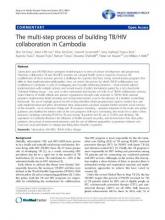
Document's year of publication: 2011-2015
Document type:
File:
| Attachment | Size |
|---|---|
| 158.91 KB |
 According to the 2023 WHO Global TB Report, Cambodia had a TB incidence rate of 320 per 100,000 population, while the... Read More
According to the 2023 WHO Global TB Report, Cambodia had a TB incidence rate of 320 per 100,000 population, while the... Read More  ឆ្នាំ ២០២៣ នេះ ជាឆ្នាំទី៣នៃការអនុវត្តផែនការយុទ្ធសាស្ត្រជាតិដំណាក់កាលថ្មី ២០២១-២០៣០ ដែលមានគោលដៅបញ្ចប់ជំងឺរបេង... Read More
ឆ្នាំ ២០២៣ នេះ ជាឆ្នាំទី៣នៃការអនុវត្តផែនការយុទ្ធសាស្ត្រជាតិដំណាក់កាលថ្មី ២០២១-២០៣០ ដែលមានគោលដៅបញ្ចប់ជំងឺរបេង... Read More  រូបមន្តស្តង់ដារនៃការព្យាបាលជំងឺរបេង នៅក្នុងកូនសៀវភៅនេះបានរៀបចំ និងកែលំអឡើងដោយផ្អែកលើរូបមន្តណែនាំ ដោយអង្គការសុខភាពពិភពលោក... Read More
រូបមន្តស្តង់ដារនៃការព្យាបាលជំងឺរបេង នៅក្នុងកូនសៀវភៅនេះបានរៀបចំ និងកែលំអឡើងដោយផ្អែកលើរូបមន្តណែនាំ ដោយអង្គការសុខភាពពិភពលោក... Read More  In 2015, WHO reclassified the countries with a high burden of TB from 22 high TB burden countries in the previous list to 30... Read More
In 2015, WHO reclassified the countries with a high burden of TB from 22 high TB burden countries in the previous list to 30... Read More  The National Strategic Plan (NSP) to End TB 2021-2030 sets out the directions and key initiatives that the National Centre for... Read More
The National Strategic Plan (NSP) to End TB 2021-2030 sets out the directions and key initiatives that the National Centre for... Read More 
Document's year of publication: 2011-2015
Document type:
| Attachment | Size |
|---|---|
| 158.91 KB |